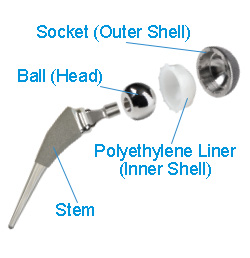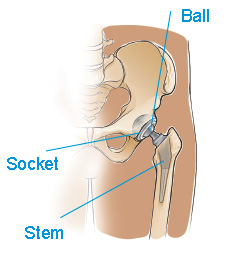Is it time for hip replacement?

The outer shell of the new socket is usually made of metal. The inner shell, or liner, can be made of ceramic, metal, or a plastic called polyethylene. When a metal or ceramic ball is joined with the socket, the new hip can produce smooth, nearly frictionless movement. The stem, which fits into the thigh bone, is commonly made of titanium.
 Did you know? Trabecular Metal™ Material, used exclusively in Zimmer replacement joints, acts remarkably like natural bone. And like natural bone, it allows existing bone and tissue to grow right into it.3,4 With its excellent flexibility, it’s simply The Best Thing Next to Bone®.
Did you know? Trabecular Metal™ Material, used exclusively in Zimmer replacement joints, acts remarkably like natural bone. And like natural bone, it allows existing bone and tissue to grow right into it.3,4 With its excellent flexibility, it’s simply The Best Thing Next to Bone®. That’s a question you and your orthopedic surgeon will have to answer together. But when non-surgical treatments aren’t providing enough relief for you to enjoy life the way you’d like, the time may be right.
Here are some signs to consider:
- hip joint damage is visible on X-ray
- you have frequent pain, swelling, and stiffness in your hip
- the pain and stiffness in your hip interferes with your daily life and limits your mobility
Your doctor may decide that surgery is not appropriate if you have an infection or if you lack the bone mass or bone strength to support an artificial hip.
What is a hip replacement?
It’s the same idea as having most things fixed—worn parts are taken out, and new parts are installed in their place. Hip replacement involves replacing the painful, damaged parts of the hip with artificial parts called prostheses or implants. To replicate the action of your original joint, a hip replacement has 3 parts: socket, ball, and stem.
How long does hip replacement last?
Many factors contribute to an artificial hip’s longevity, including the patient’s physical condition, activity level and weight, as well as the accuracy of placement during surgery. But, while there are no guarantees, the numbers are encouraging. Studies show that more than 80% of all hip replacements across the industry last at least 15 years, and more than 70% last at least 20 years.2
Individual results may vary. Your results will depend on your personal circumstances. And just like a natural hip, how well the materials in an artificial hip withstand the wear and tear that come with everyday use and rotation of the hip joint contributes to how long the artificial hip will last.
The final decision about whether or not to have hip replacement surgery will be yours, so you will want to understand the risks and benefits involved. Talk with your doctor if you have specific questions about these risks.
Hip replacements are not “one size fits all.” A properly sized and shaped joint, and the positioning of the joint during surgery, are vital in meeting patient needs. And just like a natural hip, how well the materials in an artificial hip withstand the wear and tear that come with everyday use and rotation of the hip joint contributes to how long the replacement will last.
Minimally Invasive Options
 DID YOU KNOW? Zimmer Longevity® Highly Crosslinked Polyethylene hip liners are made of a very strong material that is highly wear resistant. The Longevity Liner also offers many size and shape options, to allow surgeons to optimally fit hip replacements to many different patients.
DID YOU KNOW? Zimmer Longevity® Highly Crosslinked Polyethylene hip liners are made of a very strong material that is highly wear resistant. The Longevity Liner also offers many size and shape options, to allow surgeons to optimally fit hip replacements to many different patients. Traditional hip replacement surgery involves a long incision (10 to 12 inches) and a lengthy rehabilitation. Over the past decade, however, minimally invasive techniques have been developed.
Zimmer MIS Hip Replacement
Compared to traditional surgery, Zimmer’s Minimally Invasive Hip Replacement procedures involve less cutting or manipulation of skin, muscle, ligaments, and tendons. In fact, some procedures require no cutting of muscles or tendons. The result is that hospital stays after Zimmer MIS Hip Replacement can be less than half as long as hospital stays following traditional surgery. Your results will depend on your personal circumstances. Not everyone is a candidate for minimally invasive hip replacement. Talk with your surgeon to determine if this procedure is the best option for you.
Additional information on artificial joint materials is available at zimmer.com.
